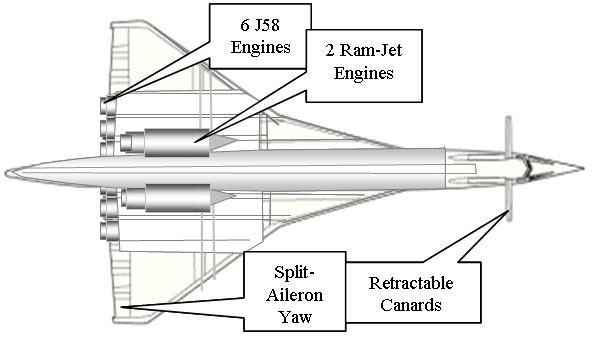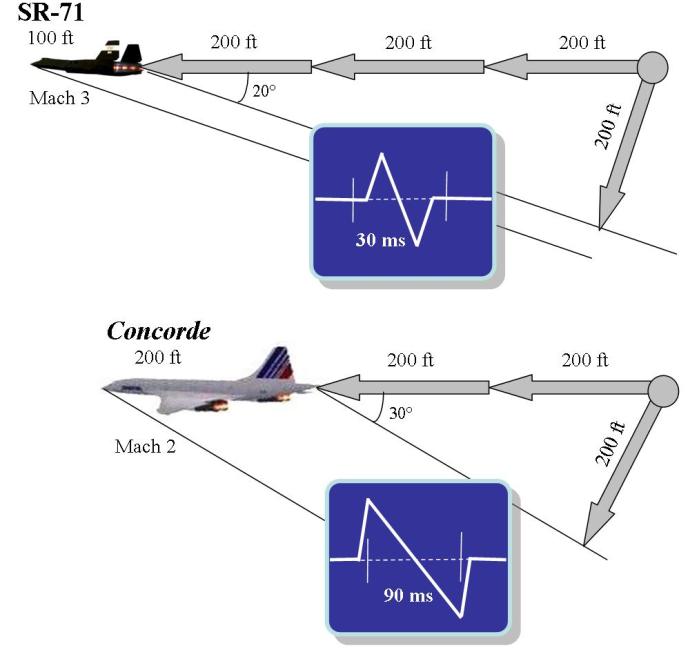|
Copyright ©2011 by Paul Niquette. All rights reserved. |
||||
 Topics in
aerodynamics seem to be amenable to empiricism more
than theory -- wind-tunnels more than calculus.
The puzzle asks, "What remedies for the sonic boom
would you propose that might enable the world's fastest airliner to fly at supersonic speeds over
inhabited areas?" Without access to fast flying
machines for experiments aloft, solvers will need to
rely on intuition for evaluating propositions for
sonic boom abatements.
Intuition,
in this case, won't always work... Topics in
aerodynamics seem to be amenable to empiricism more
than theory -- wind-tunnels more than calculus.
The puzzle asks, "What remedies for the sonic boom
would you propose that might enable the world's fastest airliner to fly at supersonic speeds over
inhabited areas?" Without access to fast flying
machines for experiments aloft, solvers will need to
rely on intuition for evaluating propositions for
sonic boom abatements.
Intuition,
in this case, won't always work...
{1} Airspeed: Faster or Slower? Something of a surprise here: Flying slower does not help (unless, of course, the airspeed is reduced to below the speed of sound -- so much for the world's fastest airliner). Counter-intuitive as it may be, flying faster is the way to go.For an illustration, consider the SR-71 Blackbird, arguably the fastest airplane in the world. Since the middle sixties, the SR-71 had been flying at over Mach 3.0 as depicted in this sketch...
...in which you will notice how its shock cone diverges at 20o, thus wrapped in an expanding circle closer to the flight path than that for Concorde at 30o. That may serve as a rationale for why the "boom signature" for the SR-71 at Mach 3 was less harmful than that of Concorde at Mach 2 by a factor of two. For sure, but there's more to the story... {2} Fuselage: Lengthen or Shorten? As indicated in the sketch above, the fuselage of the SR-71 is half that of Concorde. At Mach 2, the duration of its N-wave would be 45 ms. With its speed increased to Mach 3, the SR-71 generates an N-wave of 30 ms vs 90 ms for Concorde.Some solvers will infer that 'destructive interference' may have existed between the over-pressure boom and under-pressure boom in rapid succession, partially canceling each other out. Perhaps such a phenomenon augurs in favor of supersonic business jets in the future. Experiments in 2006 with an ingenious aircraft called quiet spike, which can telescope its fuselage length in flight, provided evidence to the contrary -- that a longer airframe 'smears out' the N-wave and reduces its harmful effect. Go figure.{3} Wingspan: Longer or Shorter? Longer, maybe. One proposal is a tailless flying wing. The concept is to put the whole aircraft inside the wing, eliminating the fuselage and its N-wave altogether. Solvers must wait for experimental results. If ever there are any experiments..{4} Shape of the Aircraft: Redesign? To address this alternative, the most ambitious experimental programs to date is the two-year Shaped Sonic Boom Demonstration, which concluded in 2003 with the so-called 'quiet supersonic platform'. The official photographs are available here. Mach 3 SST: A Proposal

|

